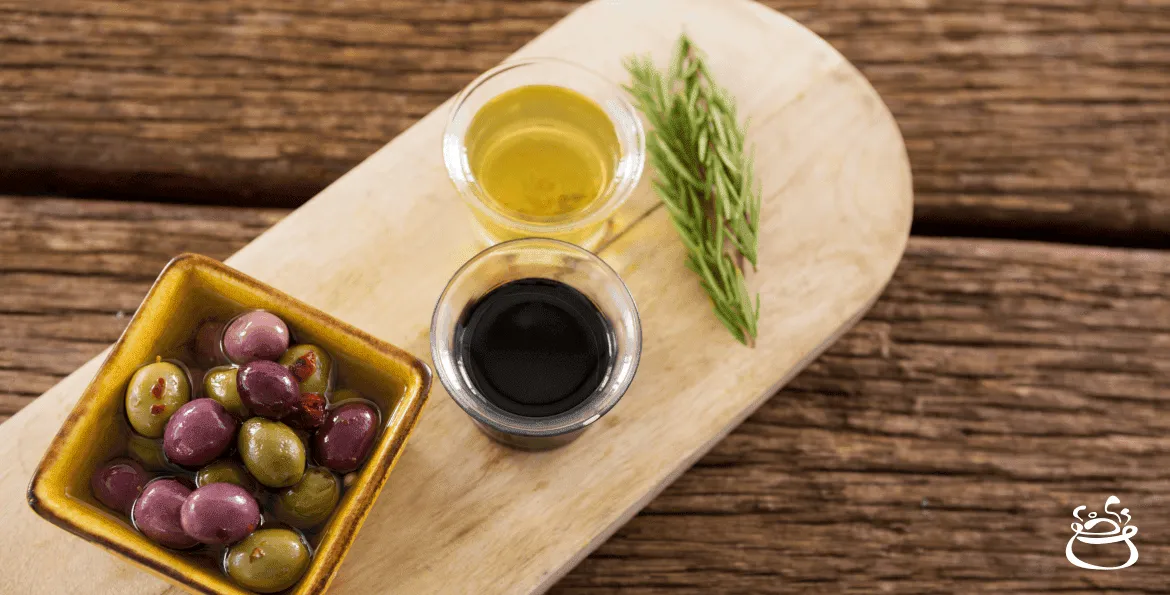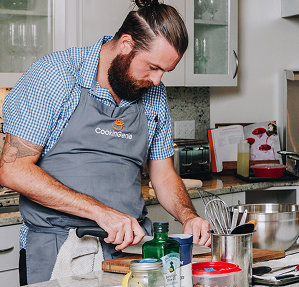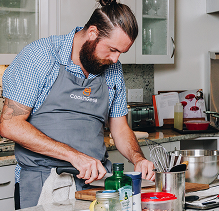Unlock Deliciousness: Using Oil and Vinegar for Optimal Emulsion
Oil and vinegar emulsion is a sauce commonly used to dress salads, sandwiches, and other dishes. This versatile sauce has been around for hundreds of years, but its recent popularity has made it a staple in many households. It’s easy to make, low in calories, and fat-free, making it an ideal choice for those looking to add flavor without extra calories.
Oil and Vinegar are the two main components of this emulsion, with oil typically being olive oil or any other light vegetable oil.
Vinegar can range from white wine vinegar to balsamic, depending on your preference. Oil and Vinegar are essential in creating an optimal emulsion – where the two ingredients bind together so well that you can’t separate them even when shaken vigorously. An optimal emulsion happens when you combine these ingredients in equal parts with a ratio of three parts oil to one part vinegar (3:1).
Ready to Book a Chef? Drop your requirement below
Emulsifying oil and Vinegar elevate your culinary creations by offering a distinct advantage in flavor balancing. The unique technique brings out the taste profiles of various Vinegar, such as sweetness and tanginess, creating a harmonious blend. Unlike traditional methods of mixing oils first and Vinegar later, this approach prevents an excess of acidity and results in a thicker consistency that comes naturally from the interaction of the ingredients without the need for extra thickeners.
Planning is vital when making this type of recipe. Measuring your ingredients ahead of time is essential, as the wrong ratios can lead to a disaster. Too much acidity from undiluted Vinegar can ruin the taste and texture of your food. On the other hand, over-dilution by adding too much liquid can compromise the binding properties between ingredients. The key to a successful dressing is balancing all ingredients, combining their strengths to create a harmonious entity ready for consumption. That’s why mastering the art of oil and vinegar emulsions is crucial for creating delectable dressing recipes.
Basic Principles of Emulsification
The essence of emulsification lies in transforming the physical properties of liquids, allowing them to be combined and stay stable for a certain amount of time.
The three basic principles behind emulsification are:
- Dispersion: This refers to breaking down the droplets or particles of one liquid into smaller particles and distributing them throughout another liquid. The dispersion process requires mechanical action, such as stirring or blending, to decrease particle size and allow the liquids to mix without separating immediately.
- Emulsifying Agent: Often referred to as surfactants, emulsifying agents are molecular compounds with hydrophilic (water-attracted) and lipophilic (oil-attracted) properties on their surface structure. These agents bind oil droplets effectively in water-based solutions, resulting in a uniform dispersion throughout the mixture. Examples of emulsifying agents include lecithin from egg yolks and common cleaning agents such as dish soap and laundry detergent.
- Stabilization: Combining diverse types of liquid molecules often leads to separation due to their differing polarities. However, stabilizing techniques such as incorporating natural gums like xanthan gum or carrageenan can increase solution viscosity, providing greater stability even after dispersion. This results in longer-lasting products with a longer shelf life. Additionally, adding ions such as sodium chloride or calcium helps prevent solutions from breaking apart while maintaining the desired texture and taste in food products that commonly use emulsions.
Do Oil and Vinegar Mix? / Does Oil and Vinegar Mix?
Oil and vinegar do not naturally mix because they have different polarities—oil is non-polar, while vinegar is a water-based liquid with polar properties. When combined, they quickly separate unless an emulsifier, like mustard or egg yolk, is added. Vigorous shaking or blending can temporarily create an emulsion, but without a stabilizer, the mixture will eventually separate.
Oil Emulsion
An oil emulsion is a mixture of oil and water-based liquids that are dispersed and held together using an emulsifying agent. This process prevents separation, creating a smooth and stable blend. Common examples include salad dressings, mayonnaise, and sauces. Emulsifiers like lecithin in egg yolks or mustard help bind oil and water, enhancing texture and consistency.
Is Oil and Vinegar Healthy?
Oil and vinegar are a healthy combination, commonly used in salad dressings and marinades. Olive oil provides heart-healthy monounsaturated fats and antioxidants, while vinegar aids digestion and helps regulate blood sugar levels. Together, they enhance nutrient absorption and offer a flavorful, low-calorie alternative to heavier dressings. Choosing high-quality oils and natural vinegar maximizes their health benefits.
Different Types of Oils and Vinegar to Use
Each oil and vinegar type has unique characteristics that make certain combinations better suited for particular dishes or sauces. Let’s look at some of the most common options and their best uses.
Extra-virgin olive oil
Due to its mild flavor profile, extra-virgin olive oil is one of the most popular options for dressings and marinades. Its low acidity ensures it blends easily with acidic ingredients like Vinegar while providing enough thickness to help create an even texture throughout a dish. Furthermore, extra-virgin olive oil has anti-inflammatory properties, which can reduce overall inflammation when consumed regularly.
Coconut oil
Coconut oil comes from coconuts grown mainly in tropical regions such as India, Sri Lanka, and Indonesia. It contains healthy medium chain triglycerides (MCTs), which provide many benefits, including weight loss support, improved digestion, and balanced cholesterol levels when consumed regularly – making it ideal for salad dressings or drizzles over cooked vegetables or meats.
Toasted sesame seed oil
When using oils and Vinegar in emulsification, toasted sesame seed oil is a popular choice, especially in Asian cooking, for its rich, nutty flavor. It’s ideal for dressing salads, noodles dishes, and other types of food preparation where you want to add flavor without overpowering the dish. However, it’s essential to remember that this oil can quickly go rancid if exposed to air or light, so it should be stored in a cool, dark place to preserve its flavor and quality.
Acidic Vinegar
Dressings get a tart and acidic flavor from Vinegar. Common choices are apple cider and red wine vinegar, while balsamic Vinegar, known for its intense flavor, serves as a glaze for grilled meats when reduced. Apple cider vinegar also offers probiotic and mineral benefits. The choice between these types of Vinegar ultimately comes down to personal taste preference, but all types aid the emulsion process by breaking down mixtures and creating a smoother consistency.
Canola oil
Canola oil comes from crushing seeds from the rapeseed plant (a member of the Brassica family). Among vegetable oils, it stands out for having no saturated fat, and its neutral taste makes it suitable for emulsifying ingredients while preserving their flavors. Although most Canola oil originates from genetically modified crops, organic options are now available and offer the same benefits without the risk of GMOs. Sunflower seed-based oils are also a good option for emulsification.
Avocado oil
Avocado oil, obtained by pressing avocados, is a versatile ingredient in the kitchen. Its rich green color and superior moisture retention capabilities make it a popular choice in baked goods. With its nutritious composition, avocado oil is an ideal alternative to traditional cooking oils for emulsification. It works to blend seamlessly without breaking down the final product, resulting in a beautiful glossy finish in both cold and warm preparations.
Things to Consider When Creating a Perfect Emulsion
Creating a perfect emulsion using oil and Vinegar requires careful attention to detail, knowledge of the basic principles of food science, and an understanding of what happens when these two ingredients interact. Knowing everything before you begin is essential for achieving a satisfactory result; even minor variations in measurements or amounts can significantly alter the outcome of this culinary art.
- When making a classic vinaigrette by emulsifying oil and Vinegar, there are two key factors to remember: the varying viscosity levels of different oils and their impact on the outcome of the dressing. Incorrectly choosing an oil with the wrong viscosity can result in a dressing that is too thin and unable to hold up on salads or dishes that require a wet texture.
- The acidity level of the Vinegar also selected significantly impacts the stability of the emulsion. Vinegar with high acidity, like apple cider or balsamic, is ideal for making a thick and homogenous dressing that clings well and doesn’t slide off lettuce leaves quickly when served. It is also essential to consider taste – sweeter dressings typically work well with less acidic Vinegar, while tart varieties are better for peppery sauces. Finding the ideal combination for a desired dish requires experimentation and taste testing.
- In addition, knowing the right proportion of each ingredient to use with the others is critical. Recipes specify specific ratios of oil and Vinegar, but personal preferences may result in slight variations towards more oil or Vinegar. Striking a balance between them ensures the perfect texture without being excessively rich or heavy from too much fat.
- Lastly, adding salt enhances the flavor and reduces separation by increasing the water content. The salt and the oil-vinegar mixture must not overpower each other, or it will ruin the blend. Take the time to get all the details right for making a perfect emulsion using oil and Vinegar.
Tips to follow for perfect emulsification of oil and Vinegar
- Start with high-quality oil and good-quality vinegar. Quality is the most critical factor when making an ideal emulsion, as using subpar oils and Vinegar will affect the outcome of your emulsion.
- Place the oil and Vinegar in separate bowls or containers so you know exactly how much each ingredient you use for your emulsion.
- To make an emulsion using oil and Vinegar, create an acidic base by mixing equal parts of lemon juice or white wine vinegar with the desired ratio of oil and Vinegar. This base helps the two substances merge more efficiently and prevents separation. Then, add additional ingredients, such as herbs and spices, to create a flavorful and well-combined emulsion.
- To create an emulsifying agent, add one or two tablespoons of water (depending on preference) to the bowl containing the acidic base. Whisk vigorously for several minutes until it thickens, like when an egg white is beaten energetically with a fork.
- Now that you have prepared the acidic base, mix all remaining ingredients into one bowl (including herbs/spices). Make sure they’re well blended before pouring them over the pre-made acidic base – ensure all components are mixed thoroughly, but don’t worry if some bits remain unincorporated; that’s why we used our pre-made agent.
- Blend all ingredients using a blender or immersion blender, making sure not to blend too vigorously, as this may create air bubbles and affect the desired texture. If using an electric blender, no additional liquid will be required.
- After even blending, pour the mixture over the previous blend until it reaches the desired consistency. If not yet satisfactory, add more liquid carefully, being mindful of maintaining the balance of liquids and solids from the previous step, which could affect the flavor and taste.
- Gently cook the mixture over low heat while stirring with a wooden spoon until you achieve the desired consistency. Depending on the stove setting, this process should take approximately 20 minutes. Keep the lid off the pot to allow steam to evaporate and preserve the desired flavors.
- Store the finished product in a container and let it cool at room temperature for 12 hours or in the refrigerator if desired. This process allows for the full release of aromatic potential. With efficient mixing techniques, the mixture should have a creamy yet semi-solid appearance. Enjoy the well-formed delight after it has chilled adequately. Experimentation and patience will lead to a successful outcome.
- Lastly, follow proper food handling procedures to avoid spoilage and the growth of harmful bacteria. Clean your utensils, wash your hands frequently, check expiration dates, and regularly monitor the product’s condition, following the guidelines provided. Adhering to basic food safety rules will make the emulsification process more manageable and help you achieve consistent results.
Recipes and Ideas for Oil and Vinegar Dressings
Oil and Vinegar Dressings provide an easy way to add flavor to salads, sandwiches, and other dishes. This type of dressing has become increasingly popular in recent years due to its subtle yet delicious flavor. Here are some recipe ideas for making your own oil and vinegar dressing with emulsification:
Honey Mustard Vinaigrette
This dressing is made by mixing equal parts of olive oil and raw apple cider vinegar or white balsamic Vinegar, then add in 1 tablespoon of honey, two teaspoons of spicy mustard, one teaspoon of grated garlic, ¼ teaspoon of sea salt, and two tablespoons of chopped fresh herbs (such as basil or oregano). Mix all the ingredients in a bowl until well incorporated. Store any remaining unused portion in the refrigerator for up to 7 days.
Classic Italian Mozzarella Salad Dressing
This is another classic combination; mix three parts extra-virgin olive oil with one part red wine vinegar and season with ½ teaspoon each dried oregano, basil leaves, pepper flakes & coarsely ground black pepper along with ¼ teaspoon each garlic powder & granulated sugar & 1/8 teaspoon fine sea salt; whisk everything together until smooth. Drizzle over fresh mozzarella salad for something unique.
Raspberry Shallot Vinaigrette
To make this fruity yet savory vinaigrette, combine two parts canola oil or extra-virgin olive oil & one part raspberry balsamic OR raspberry flavored rice wine vinegar. Stir two heaping tablespoons of freshly minced shallots (or about four shallot slices) into the mixture before stirring it all together until smooth. Perfect for adding some color & contrast over green salads or as a dipping sauce for grilled vegetable skewers.
Orange Thyme White Balsamic Vinaigrette
For this recipe, mix two parts of a good quality cold-pressed virgin olive oil & one part white balsamic vinegar. Their depth of flavor compliments each other nicely when combined in equal portions. Next, you’ll need three tablespoons of freshly snipped thyme leaves (or substitute dried if necessary), ¾ cup freshly squeezed orange juice + zest from ½ orange, plus ½ teaspoon fine sea salt. Whisk it all together vigorously until emulsified then you’re ready to dress some tasty greens.
Carrot Ginger Sesame Dressing
This Asian-inspired Carrot Ginger Sesame Dressing is easy to make. Blend four cloves of garlic scapes (or milder garlic chive blossoms) with three peeled, cubed carrots and three thin slices of ginger root after boiling them. Add the hot veggie mixture to a blender with ⅓ cup sesame paste, ⅓ cup light soy sauce, ¼ cup lemon juice, and a pinch of salt. Blend until creamy. You can store this dressing in the refrigerator for up to 10 days.
Roasted Walnut Parsley Red Wine Sauce
In a medium bowl, mix half a cup of lightly roasted walnut pieces and 4 ounces of cabernet sauvignon red wine – both ingredients are crucial, so don’t leave either out. Continuously stir or whisk in 5 ounces of mild extra virgin olive oil, and finish by adding a handful of finely chopped flat-leaf parsley leaves. This recipe makes approximately 14-16 ounces, depending on the amount of grapes used. Store any leftover sauce at a cool room temperature, away from direct sunlight.
Conclusion
Emulsifying oil and Vinegar have significantly impacted the food industry with their use in various dishes, from salad dressings to marinades. The combination adds a unique texture and provides multiple health benefits, such as improved digestion and lower cholesterol levels.
In conclusion, emulsifying oil and Vinegar is a modern culinary trend that offers numerous advantages for home cooks and the restaurant industry. Whether you’re looking to enhance your meal with new flavors or improve its nutritional value, incorporating this technique into your cooking is worth considering. With their exciting possibilities, emulsifying oil and Vinegar are must-have ingredients in any kitchen.



 Settings
Settings
 Gift Card
Gift Card Blog
Blog Locate Us
Locate Us










 Home
Home
 Chefs
Chefs
 Chats
Chats
 My Order
My Order



